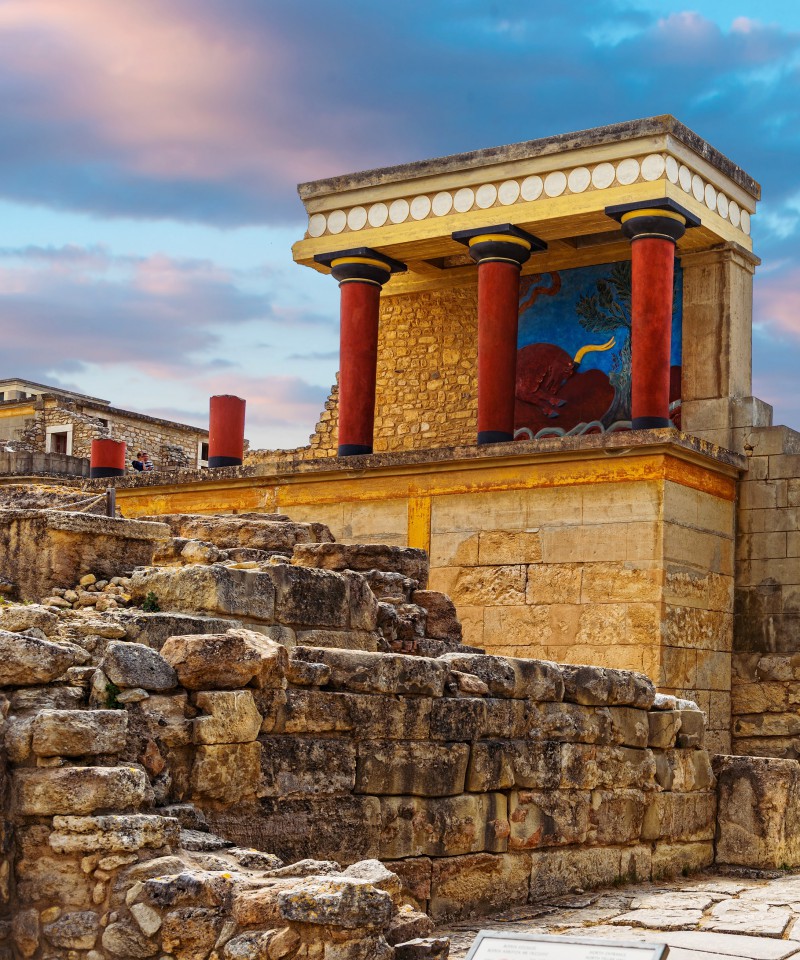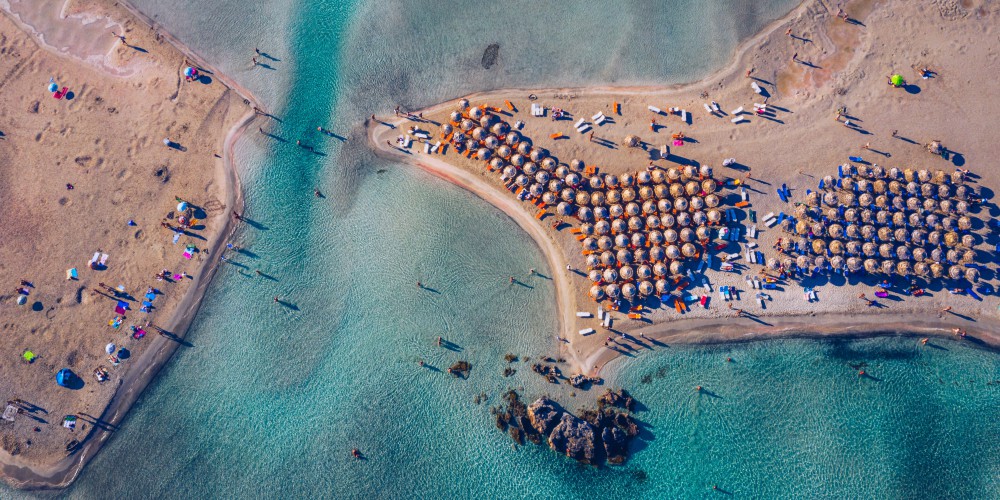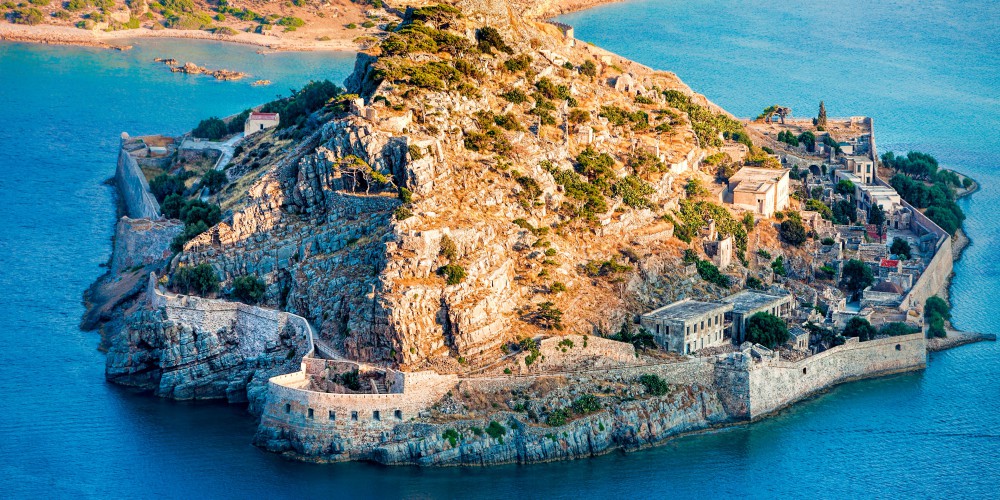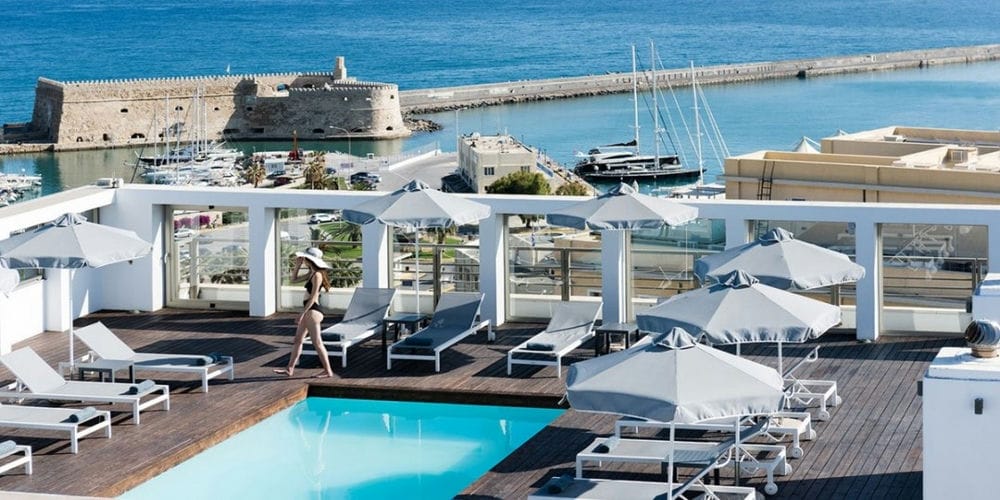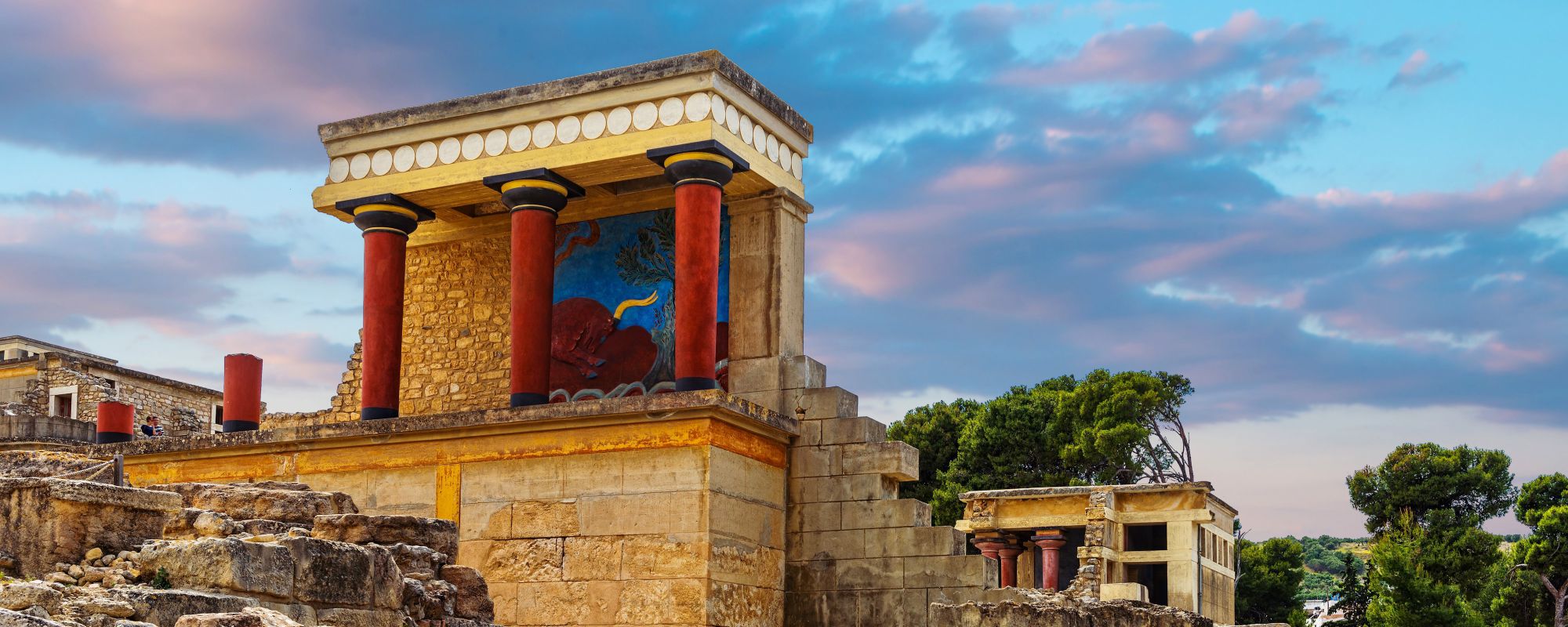
Everything You Need to Know About Knossos Palace
Key Takeaways
- Knossos Palace is Greece's largest and most important archaeological site, with a rich history dating back to the 7th millennium BC.
- The palace served as the ceremonial, political, religious, and economic center of the Minoan civilization.
- The palace's intricate structure, magnificent murals, and distinct sections make it a must-visit attraction on the island of Crete.
- The mythological tales of the Minotaur, Daedalus, and Icarus are closely associated with Knossos Palace.
The list of fascinating attractions on Greece’s largest and most historical island is long. However, at the top of the list, one finds none other than Knossos Palace.
This Minoan palace is a place of history, legends, and Crete’s most extensive and important archaeological site.
The Minoan palace is the largest, most complex, and most fancy of all in Greece. It is located about 20 minutes south of Heraklion.
Knossos Palace was inhabited for several thousand years, starting somewhere in the 7th millennium BC. It was abandoned after its destruction in 1375 BC, which also marked the end of the Minoan civilization.
If you’re planning an excursion to Knossos Palace, one of the greatest landmarks in Greece, here’s everything you need to know before going!
Historical Background
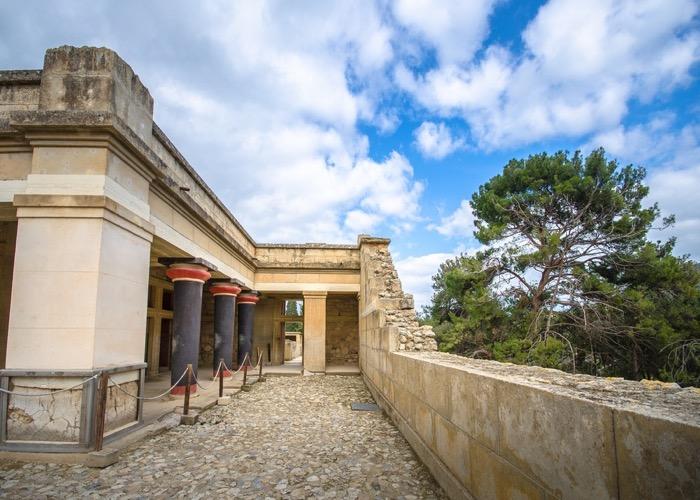
Knossos Palace was the ceremonial and political center of the Minoan Civilization during the Bronze Age. Considered Europe’s oldest city, Knossos was once the city-state of Crete, with the town surrounding the hill the Minoan palace is on.
The area actually has a very long history of human habitation, from the first Neolithic settlement around 7000 BC, until 1500 BC, when the surrounding city had a population of 100,000.
The palace suffered through an earthquake but then was reconstructed. It’s believed that the palace was abandoned around 1380 to 1100 B.C. for largely unknown reasons.
The excavation and exploration of the site have provided historians with a wealth of knowledge and insight into the Minoan Civilization.
Tools like clay and stone incised spools and whorls point to a cloth-making industry, and curvaceous female figurines indicate the worshipping of mother goddesses.
The Minoan palace structure we see today is not exactly as it looked in its original time due to reconstruction and renovation throughout the years, and some archaeologists consider it a facsimile.
The Minoan palace complex is not believed to have just been the residence of the monarch but also the civic, religious, and economic center of Knossos.
What Is The Minoan Palace Of Knossos Famous For?
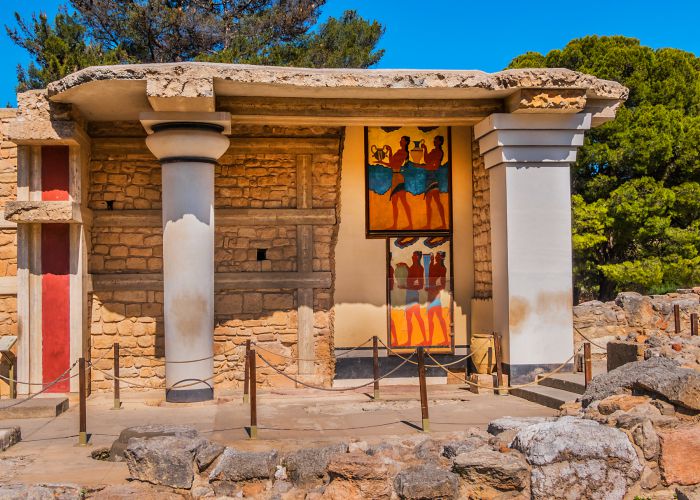
The Minoan palace of Knossos is divided into several sections, each of which has a separate use.
It was multi-story, built with carved structures, and decorated with magnificent murals depicting possibly religious ceremonies. It was accessible from three entrances located on the north, west, and south sides. Four wings develop around the central courtyard.
Thus on the west wing of the Minoan palace, there are the ceremonial halls on the upper floors and the public storerooms.
Additionally, there are the sanctuaries, the treasuries as well as the throne room. In the southwestern part of the Minoan palace are the Western Courtyard and the Western Entrance leading to the Procession Corridor.
The latter was decorated with frescoes. On the left side of the corridor are the Propylaea and the famous Double Horns. The Double Horns are one of the sacred symbols of the Minoan religion.
On the east side were the royal apartments, which led to a large staircase, staff rooms, and a sanctuary. Among the most important rooms are the Double Ax and the Queen's Apartment with the dolphin mural.
To the queen's apartment, north and east, are the main warehouses and the Zatriki Corridor. In the Zatriki Corridor, the ancients used to play a type of chess called ‘Zatriki.’ Further east were the various workshops, as well as the royal warehouses.
The north wing of the Minoan palace is dominated by the "Customs," a tank of purges, and a stone theater. From the theater starts a Cobbled Road that leads to the small palace. Finally, in the south wing, there was the majestic south Propylos.
Apart from its construction and architecture, the Minoan Palace of Knossos is most famous for its connection to Greek mythology. Namely, the tale of the Labyrinth and the Minotaur and the one of Daedalus and Icarus. We’ll unfold these mythological tales that relate to Knossos later on.
Who Built The Minoan Palace Of Knossos?
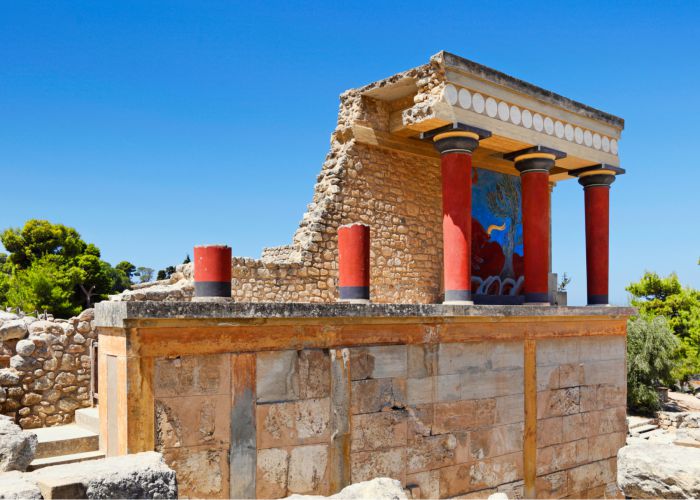
The Minoan Palace of Knossos is the largest of the centers of Minoan power. This is a building complex that is developing in an area of 22,000 sq.m. It was the most impressive of the Minoan palaces, built on a largely artificial hill. It was the administrative center of Minoan Knossos.
According to Greek mythology, the famous architect Daedalus designed the Minoan palace with such complexity that none of those who entered could find the way out.
Daedalus is considered by most the greatest inventor of ancient Greece. He was simultaneously a real craftsman and an artist. Its artistic tendencies are even shown in his name. ‘Daedalus’ derives from the ancient Greek verb ‘daedalo,’ which means to ‘work with art.’
The Labyrinth in Minoan Crete, the thread of Ariadne, the wooden cow of Pasiphae, the harpoon of Ariadne, the bow of the ships of that time, and the flying with wings of wax were all according to mythology inventions of Daedalus.
When Was The Minoan Palace At Knossos Built?
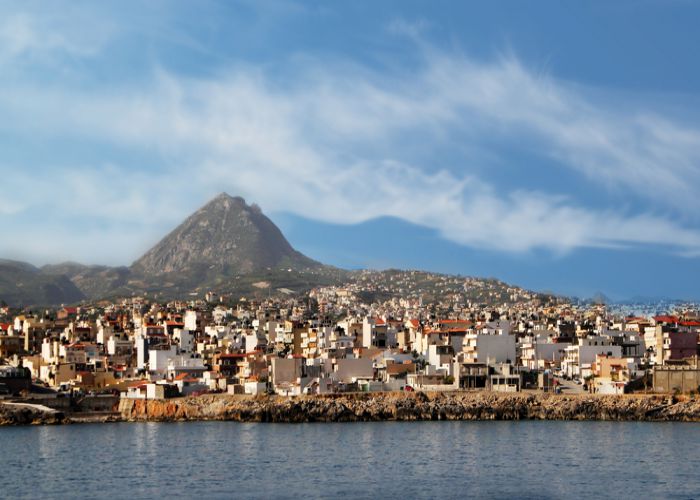 Heraklion view - credits: Valsib/Shutterstock.com
Heraklion view - credits: Valsib/Shutterstock.com
The first palace on the small hill by the river was built around 1900 BC. in the ruins of previous settlements. It was first destroyed along with other first-palace palaces in Crete around 1700 BC, probably by a major earthquake or foreign invaders.
An even more complex was rebuilt immediately. Until its abandonment, it was destroyed several times during earthquakes and invasions.
Finally, it was destroyed in 1450 BC. by the huge volcanic eruption of Santorini and the invasion of the Mycenaeans. The invasion led to Knossos being used as their capital on the island of Crete until 1375 BC.
The Throne Room Of King Minos In Knossos Palace
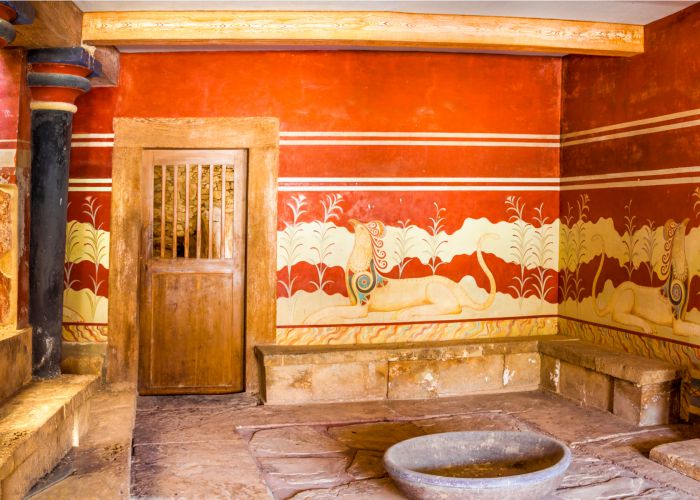
The throne room of Knossos was located on the north side of the sacred apartments. The entrance to it was from the main courtyard with a quadruple multi-door and four steps.
On one far side of this room stood a stone throne, built to mimic wood. One mural depicts a pair of griffins framing the throne. On the opposite side was a tank of purifications, indicating the sacred character of the space.
The throne room is a unique find with a purely Minoan character, although there are similarities with the Mycenaean mansion, as is known from the palace of Pylos.
The throne was considered the seat of King Minos, and the throne room as the hearing room of the citizens. Newer interpretations, however, that take into account the theocratic character of the leadership in Minoan Crete, tend to characterize the throne as hieratic and not as the throne of the Minoan leader.
It is believed that it was mainly used as a concentrator of King Minos and the priesthood. There, they used to decide on matters of law.
Mythical Background Of The Minoan Palace of Knossos
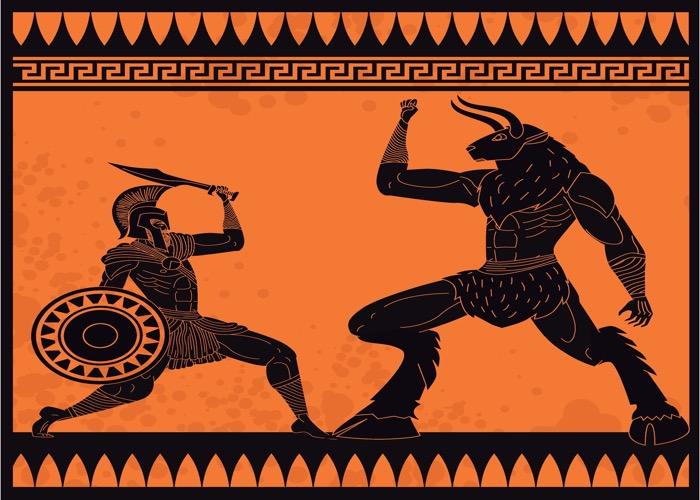
It is believed by some that the Minoan Palace of Knossos is the same palace that Greek mythology refers to in the Minotaur story.
According to legend, Theseus, a prince from Athens, whose father was an ancient Greek king named Ageaus -whom the Greek sea is named after- sailed to Crete, where he was forced to fight a terrible creature called Minotaur.
The Minotaur was a half-man, half-bull and was kept in the Labyrinth – a maze – by King Minos, ruler of Crete, who lived in his palace at Knossos. It was said that the Minotaur was the King’s son.
However, the king's daughter, Ariadne, fell in love with Theseus. When he entered the Labyrinth to fight the Minotaur, Ariadne gave him a ball of thread which he unwound so that he could find his way back by following it.
Theseus killed the Minotaur, and then he and Ariadne fled from Crete, escaping her angry father.
Knossos Minotaur
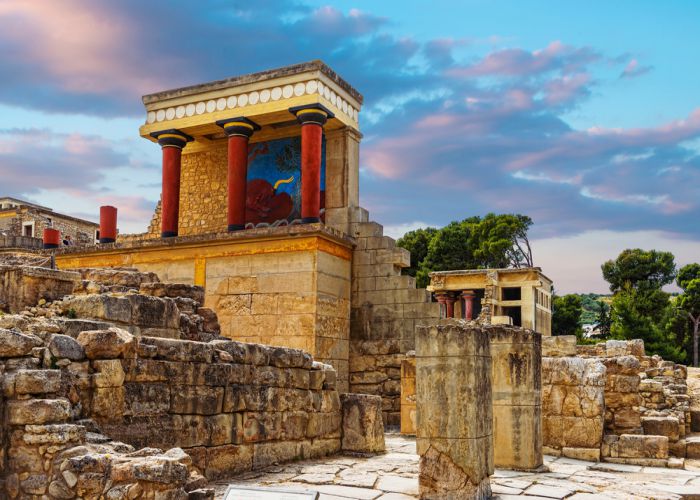 The Palace of Knossos - credits: Scorpp/Shutterstock.com
The Palace of Knossos - credits: Scorpp/Shutterstock.com
As we have already mentioned, the Knossos Palace has been associated with two of the most well-known tales of Greek Mythology. One of them is the tale of the Labirynth and the Minotaur.
According to mythology, King Minos was the child of the Phoenician princess of Europe, who was kidnapped by Zeus in the form of a bull. He had been given the right to be king and to make all the laws by his divine father, whom he consulted every nine years.
Zeus was strongly associated with Crete, having been born and raised here (in Psiloritis), and is sometimes believed to have been the island's first ruler. The Cretans even have his tomb here.
Minos was married to Pasiphae. When the people of Crete once defied their right to the throne, Minos replied that the gods decided to be this King.
As a sign of this, Poseidon sent a bull to sacrifice the king, but he was so handsome that Minos decided to keep him, sacrificing one of his own bulls.
This infuriated the god of the sea and made Pasiphae fall in love with the divine bull. The result of this bond gave birth to a child, the Minotaur.
The famous architect and inventor Daedalus, who worked for Minos, built a labyrinth for the king, for which he would close the Minotaur, who was half human and half bull. Minos' son Androgeos had gone to Athens to compete in the games there.
He won, but the king of Athens sent the young man to kill a bull in Marathon. However, the bull killed Androgeos, and when Minos found out, he declared war on Athens. Zeus destroyed the city, and its king was forced to do whatever Minos asked him to escape the wrath of the god.
Minos asked the king of Athens to send seven young girls and seven young boys to Crete to be sacrificed to the Minotaur every nine years. This continued until the hero Theseus stood as one of the young men to be sacrificed.
Minos' daughter Ariadne fell in love with him, and together with Daedalus, they helped him defeat and kill the Minotaur. Afterward, Theseus took Ariadne with him on the return journey to Athens but left her in Naxos.
Minos punished Daedalus and his son Icarus by locking them in the labyrinth, where they later escaped with the wings that Daedalus had made.
Daedalus' escape from Crete is one of the most famous stories in Greek mythology. He made wings for himself and his son with candle and bird wings, and so they flew to freedom.
However, despite his father's warnings, Icarus flew very close to the sun, and the candle with which his wings were stuck melted, and Icarus fell and drowned in the sea, which has since been named after the Icarus Sea.
Daedalus arrived in Sicily and found refuge in the court of King Kokalos. Minos set out to hunt down Daedalus, but when he arrived in Sicily, he was killed by the daughters of King Kokalos. After his death, Minos became one of the lords of Hades.
Daedalus And Icarus
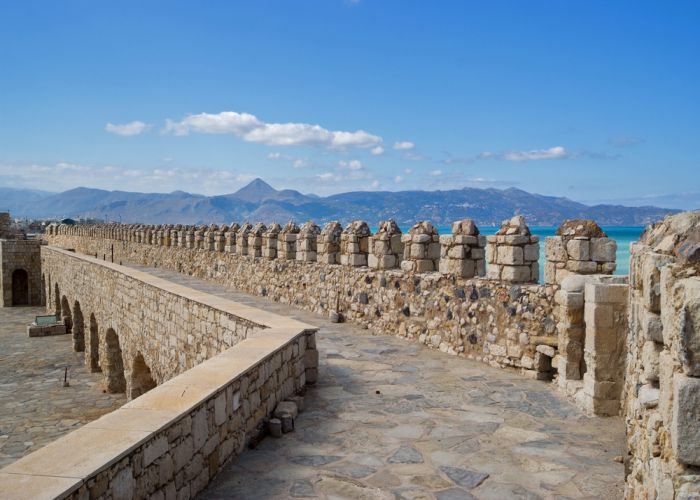 Heraklion fortress - credits: Lejczer/Shutterstock.com
Heraklion fortress - credits: Lejczer/Shutterstock.com
The other popular tale related to Knossos is one of 'Daedalus and Icaros.' Minos was terribly angry when he learned that Daedalus made it easy for Pasiphae (his wife) to satisfy her insane love affair with the bull of Poseidon (from this paradoxical union, the Minotaur was born).
Enraged, Minos definitively forbade the departure of Daedalus and his young son Icarus from Crete. Daedalus had acquired Icarus with Nafsikrates, one of the slaves of Minos.
Daedalus began devising ways to escape them. Escape from the sea was impossible. Armored ships patrolled the Cretan coast. Only from the air would their escape be possible. But how;
Daedalus' inventive mind did not take long to find the solution. He made giant feathers from wicker twigs and cloth and glued them with wax.
He advised his son how to fly, waxed his wings on his shoulders, and flew together over Crete's high mountains for freedom. The spectacle they witnessed was unique, and the trip to the ethers was unrepeatable.
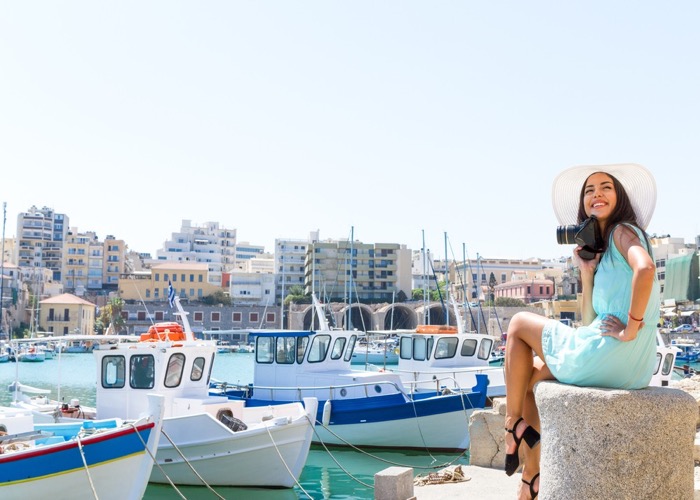 Girl in Heraklion - cedits: G.PAGOMENOS/Shutterstock.com
Girl in Heraklion - cedits: G.PAGOMENOS/Shutterstock.com
The man tore the blue horizon for the first time and conquered the celestial roads. They left slavery behind and traveled to distant and dreamy places.
Like a newly hatched bird, flooded with happiness, Icarus sometimes flew high, greeting the bright Sun, and sometimes low, cooling its wings in the blue waters of the sea. In vain, his father shouted at him not to approach the bright disk of the Sun.
Evil came quickly. The hot rays of the Sun softened the candle and melted the bindings of the wings. The unfortunate young man fell into the sea near an island and drowned. Fate stood hard for the mindless and reckless young man.
Daedalus, in agony, came down and looked around the dead body. The island that was buried was named Ikaria, and the sea that Icarus drowned in was named 'Ikario.'
Uncomforted, Daedalus arrived in Kymi, where he built a temple in honor of the god Apollo, to whom he dedicated the wings that gave him freedom.
Knossos’ Artifacts At The Αrchaeological Μuseum of Heraklion
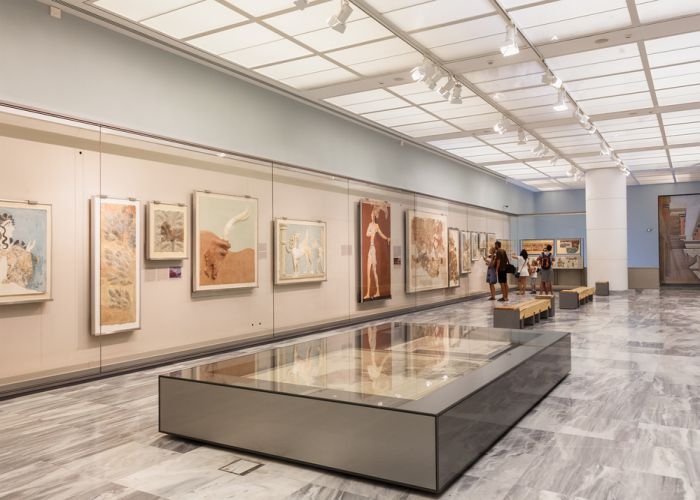
Once you have finished your tour of the ruins of this great civilization, it will be time to visit the Heraklion Archaeological Museum and get an even better taste of Minoan grandeur.
The Heraklion Archaeological Museum is ranked second in terms of traffic, nationwide, after the Acropolis Museum.
It is considered one of the most important museums in Europe. It is located in the heart of the city of Heraklion. During the Venetian occupation, the catholic monastery of St. Francis was located here. It was destroyed by the earthquake of 1856.
It was the most important and richest monastery in Crete, decorated with exceptional Byzantine frescoes. Construction of the museum began in the early 20th century and was completed in 1940.
On the museum's ground floor, there are 13 rooms open to the public, while on the first floor, there are pieces from the original murals from the Minoan Palace of Knossos.
All the exhibits of the Museum of Heraklion come exclusively from the archeological sites of Crete, and their exhibition has been done over chronological periods.
The famous Disk of Phaistos is unique in its kind, with hieroglyphic writing points and ideograms. The contents of our album are unknown.
Remarkable is the gold jewelry found in Minoan necropolises, the mirrors with ivory handles, the eyebrow tweezers, the ivory combs, as well as the swords with golden handles.
Excavations Of The Palace of Knossos
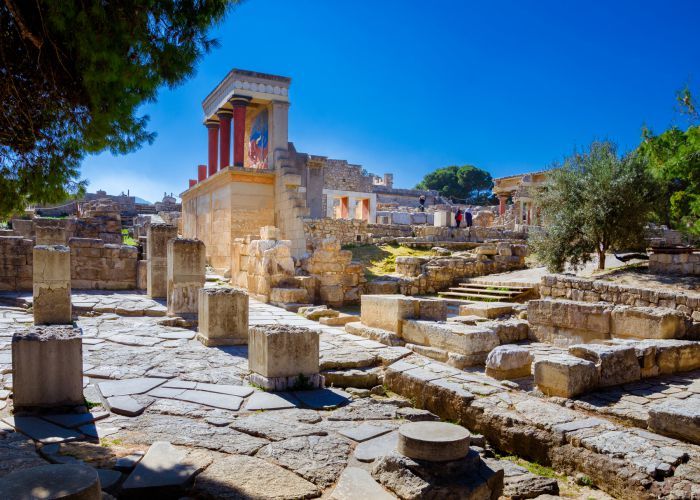
Excavations have shown that there was a settlement here in the 8th millennium BC, perhaps even before, and that a palace existed as early as the 4th millennium BC.
The foundations of many palaces have been found, and most of what we see today belong to the period between the 16th - 14th centuries BC. It has later constructions after the end of the Minoan civilization, but this does not mean the end of the inhabitants here.
Knossos palace was to become an important settlement during the Mycenaean period, as well as during the Hellenistic and Roman eras, and was not abandoned until the Middle Ages.
The 1st Excavation at Knossos, Heraklion by Minos Summer
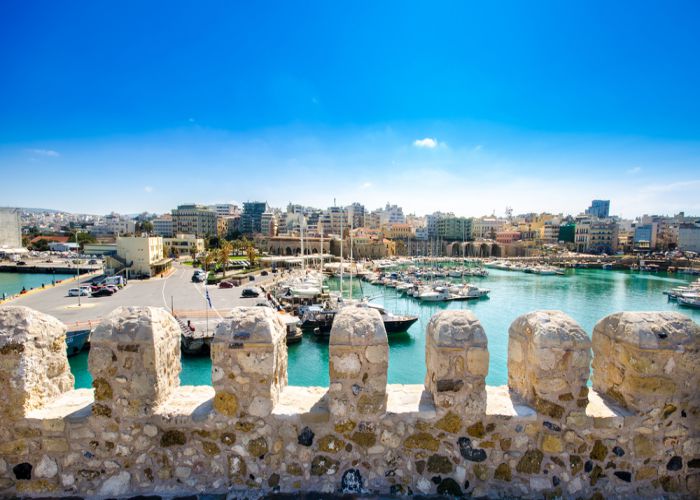 Heraklion harbor - credits: Georgios Tsichlis/Shutterstock.com
Heraklion harbor - credits: Georgios Tsichlis/Shutterstock.com
The first major excavation was carried out in 1878 by the wealthy art lover from Heraklion Minos Kalokairinos, while Crete was still under Turkish occupation. Minos Kalokairinos excavated part of the western warehouses and brought to light many large 'pithos.'
Excavations by British archaeologist Arthur Evans
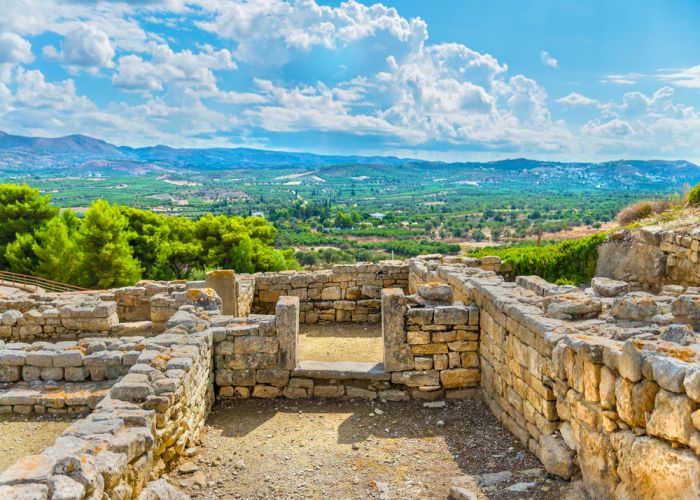
In March 1900, Arthur Evans excavated not only the palace but also the wider area of Knossos. The excavation lasted until 1931, while the palace complex was excavated in 5 years, a time that is considered minimal with current methods and techniques.
Arthur Evans proceeded with the restoration of the palace with cement, a technique that is today criticized as arbitrary and aggravating for the Minoan edifice. Since then, archaeological research has been ongoing, and a program has been launched to protect the palace from damage.
From the findings of the excavations, we find that a female deity was worshiped in Knossos. The figures with a topless woman holding snakes in her hands are believed to have been the goddess of the ancient Cretans.
Another was the sacred symbol of the double ax and the bull that was also worshiped here. There were toys, the bullfights, where young men and women jumped over the bulls, while many works of art with horns and bullheads have been found in Knossos.
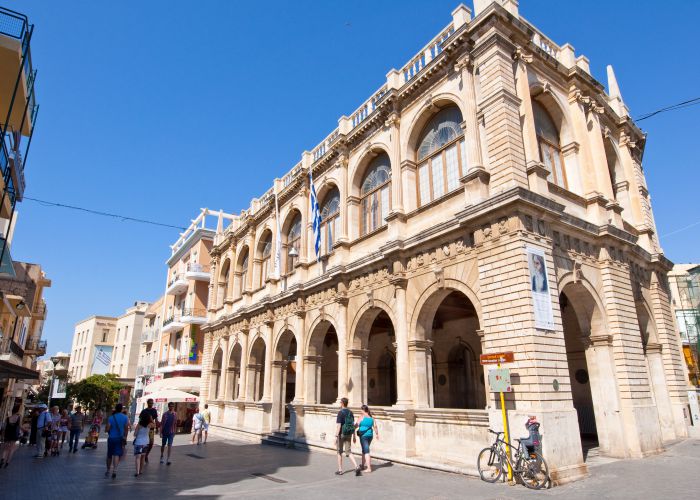 Heraklion, Crete - credits: Phototraveller/Depositphotos.com
Heraklion, Crete - credits: Phototraveller/Depositphotos.com
Also, the variety of building materials, the colored mortars, the orthomarbling, and the murals that adorn rooms and corridors made an impression.
The high technical knowledge of the Minoans is confirmed by original architectural and construction inventions, such as skylights and multi-doors, the use of beams to strengthen the masonry, as well as the complex sewerage and water supply network.
It is not certain what people lived here from the depths of prehistory. The Achaeans invaded in the 15th century BC., and their culture brought the Minoan civilization to its peak.
They spoke Greek, had Greek gods, and used Knossos as a center. They also used the so-called Linear B script, which has been found on clay tablets.
The end of the Minoan civilization was probably caused by natural disasters. The earthquake that sank half of Santorini in 1450 BC seems to have destroyed most of the buildings in Crete.
What To Expect In Knossos Palace
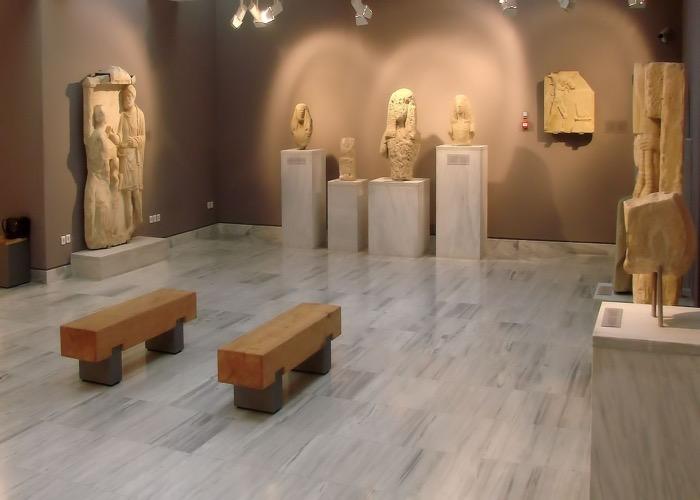
The archaeological site of Knossos Palace comprises about 20,000 square meters and over 1,500 rooms, as well as old village ruins in the surrounding hillsides of the palace complex. Be prepared to walk a lot!
The most important part of the site is the Great Palace. The palace’s wings are arranged around a central courtyard containing the royal quarters, workshops, shrines, storerooms, repositories, the throne room, and banquet halls.
Then there’s the Little Palace, located west of the Great Palace and the second biggest building at Knossos.
 Heraklion old Venetian harbor - credits: Neirfy/Shutterstock.com
Heraklion old Venetian harbor - credits: Neirfy/Shutterstock.com
The Bull’s Head, a famous archaeological find made of steatite, was found in one of its chambers and is now exhibited in the Archaeological Museum of Heraklion. In the House of the High Priest, a stone altar was found, surrounded by double ax swords.
The Caravan Serai is located opposite the Great Palace, and it was the official entrance to the palace. It served as public baths with running water so that the traveler or visitor of Knossos could bathe before visiting the legendary King.
The Royal Temple Tomb-Sanctuary is located south of the Palace, and it is considered to have belonged to one of the last Minoan Kings.
How To Get To The Palace of Knossos
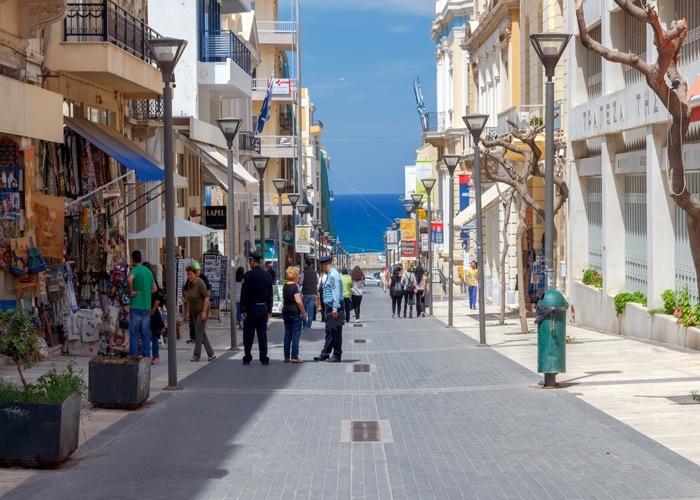
The archaeological site of Knossos, Heraklion, is extremely easy to access, adding one more reason why it is so popular among the crowds.
It is very easy to get to Knossos from Heraklion. It’s a 15-minute car drive, or you can take a bus from the main bus station at the Heraklion port. Simply take bus number 2 and stay on it until it reaches its final stop: Knossos.
The public buses are cheap at around €1.50 one-way. Be careful; there are two bus stations in Heraklion. The bus to Knossos leaves from Bus Station A.
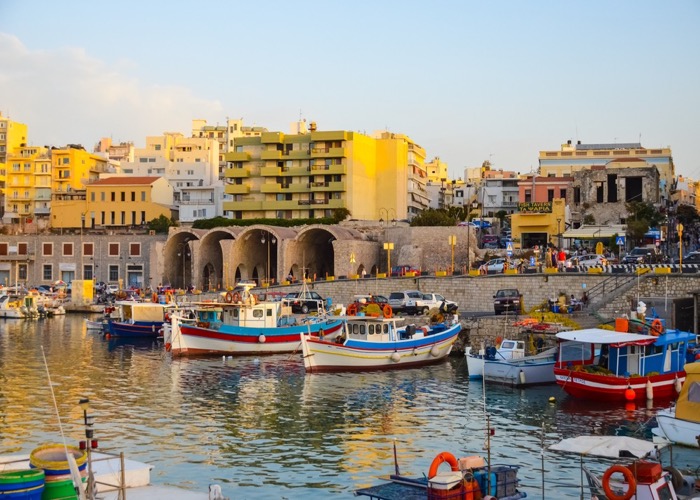 Heraklion port - credits: Sergey Lyashenko/Shutterstock.com
Heraklion port - credits: Sergey Lyashenko/Shutterstock.com
All buses to the East of Crete also leave from this station. The buses to the Knossos Palace ran daily in the high-season summer months, every 20 minutes from 8 am to 7 pm.
During winter, the routes are fewer and run only until 5 pm. If you’re spending time in Heraklion, it’s a worthy detour.
Knossos Tours; Exploring Minoan Crete
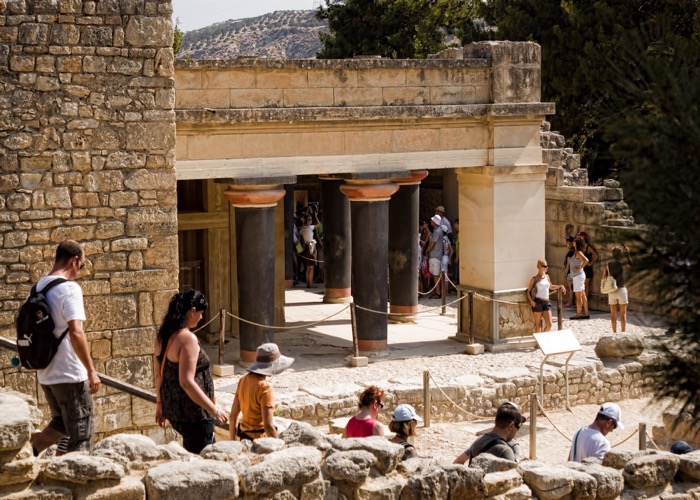
If you want to experience the grandeur of Knossos Palace and the Archaeological Museum of Heraklion, look no further.
You will enjoy guided tours across the famous archaeological site by joining one of our Greece tours. Furthermore, you’ll hear about untold stories of ancient Crete and marvel at the Archaeological Museum of Heraklion exhibits.
Opt for From Heraklion: Knossos Palace and Archaeological Museum Tour, Including Transportation for a comprehensive Knossos experience.
Alternatively, you can combine Crete’s history and gastronomy with Knossos Delights: Knossos Palace & Heraklion Food Tour with transportation. You won't be disappointed no matter which one you choose to go for!
Final Thoughts
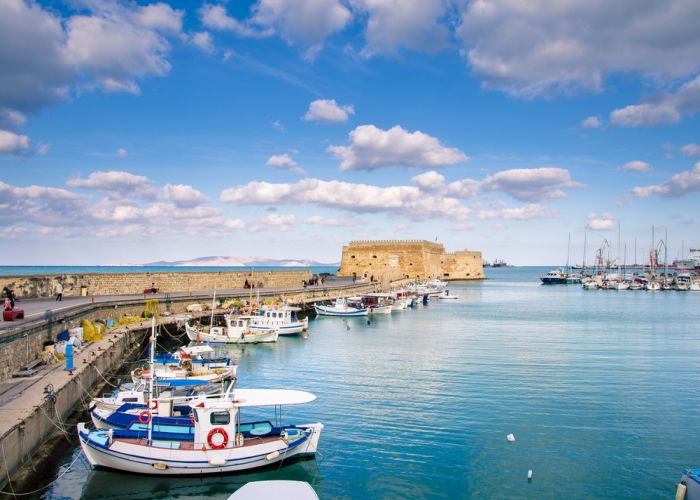 Heraklion - credits: Georgios Tsichlis/Shutterstock.com
Heraklion - credits: Georgios Tsichlis/Shutterstock.com
There is no denying that visiting Knossos Palace and the Archaeological Museum of Heraklion is a once-in-a-lifetime experience. After all, it is no coincidence that this magical site is included in all of our Greece vacation packages, including the island of Crete.
Now you have all the information you need to upgrade your experience in Crete.
It’s time to appreciate the ancient glory of the island to its full potential!
Happy exploring!






